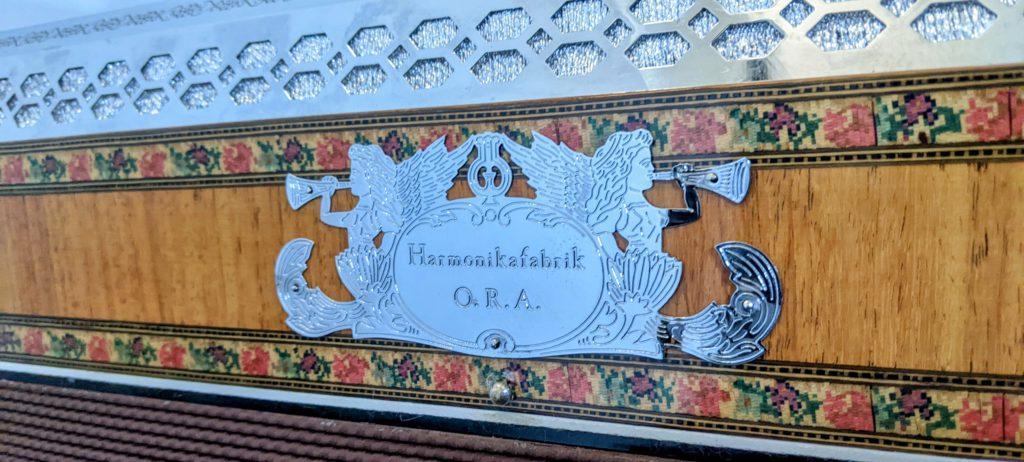
Last year I purchased an intriguing accordion from willhaben.at, a second hand Alpin IIIC by O.R.A Castelfidardo, whose only label on the instruments reads “Harmonikafabrik O.R.A”. (Shoutout to the seller Roman, who was very transparent and helpful during the sale, and my friend Klemens who visited Roman and provided videos for me 🙋♂️👋.)
Several things appealed to me:
– its light weight for a 120 bass accordion with cassotto,
– its age (estimated around 1980s or early 1990s),
– unusually traditional design that resembles more of a Steirische harmonika (curved ends of the keyboard),
– unusually lighter colour of an alpine piano accordion,
– slightly wet musette and a loud Oberkrainer sound, and deliberate lack of treble registers (similar to the very early Zupan Alpe piano accordions),
– the fact that its bass side has come from another accordion, albeit visually matching the rest of the instrument very well, but clearly younger in age due to its softer edges and corners (a more recent design).

In general it has held up very well for its age, plus endured a hell of a transit from Austria to Australia through several FedEx distribution centres, as well as several previous owners within only the last few years.
Model name – probably ‘Alpin’ or ‘Alpina’
Its suspected model name Alpin IIIC is an assumption based on the model name of the very similar Müller piano accordion from the 1980s with a similar design and sound. The “III” would denote 3 treble reeds, and the “C” for cassotto (tone chamber) on the middle or “clarinet” treble reed, which contributes to the special sound known on most Oberkrainer piano accordions including Avsenik, Burnik, etc.
Inside the accordion, including on its reed blocks, I haven’t been able to locate any interesting writing that could indicate a time period for this accordion’s manufacturing – myself and the seller both assumed late 1980s/early 1990s based on its quality, mechanics and appearance compared to other similar accordions from that period like the Müller. A few owners of similar Alpin accordions by Müller believe that this ORA is “basically the same”.
Locating information on the ORA company, or this model, has proved unsuccessful, but I’ve learnt the following so far:
- ORA may have had a role to play in the similar looking Alpin piano accordion for Austrian accordion manufacturer Müller, from around the 1980s.
- Although the badge reads “Harmonikafabrik O.R.A”, the full name of the company was “O.R.A. di Guerrini Aldo” in Castelfidardo, Italy.
- eBay listings indicate that ORA produced other styles of accordions as well, outside of the alpine market.
- ORA also produced Steirische harmonikas, which seem to be more readily available on used marketplaces like eBay, compared to their piano accordion counterparts.
- ORA had a website in the early 2000s to promote their alpine accordion models, as “Harmonikafabrik O.R.A”, with their Italian address visible.
- archive.org’s wayback machine indicates that the website popped up around 2001 and was hosted on accordions.com.
- ORA’s button accordions visually remind me of Melodija Mengeš button accordions from around the 1990s, i.e traditional asthetic and layout of decorative horns on the bass side.
- Their 1990s/2000s piano accordions were called “Alpina” (instead of “Alpin”), just like the Hohner Alpina from the same era. In fact they visually look very similar to the Hohner Alpina in terms of the Palisander wood tones, bellow colours, registers and so on (although this appearance was the standard at the time with other alpine accordion manufacturers as well, eg. Beltuna/Zupan).
- ORA used a traditional type of badge for their branding on their steirische harmonikas as well as my piano accordion, similar to the older Strasser, Melodija, Proster etc steirische harmonikas – these badges would often feature dragons or angels. Some more recent Öllerer brand Oberkrainer piano accordions (such as this one linked here) also feature this kind of badge.
- Someone from Austria commented on a video: “these ORA was in vienna for sale (very cheap)… So excellent and the same as the label Müller from Austria in the late 80ies…”.
– From that comment I could assume that the price tag on these accordions could have been lower due to the lack of treble registers. - O.R.A had ceased manufacturing only a few years ago, possibly during the 2010s. Because it is hard to locate many second hand O.R.A accordions, I would assume that they may have focused on manufacturing for other brands which were better known in the market. In fact this piano accordion could have an attempt to enter the Oberkrainer piano accordion market(?), which was dominated by the Hohner Alpina, Zupan Alpe and Hohner Morino at the time.
❓Do you know anything about this mysterious alpine accordion brand? Leave a comment below.
Below are videos of similar accordions from the same time period that could be related, from around the 1980s and 1990s
Peter Lamprecht

Muller accordion – Salzburg Alpenexpress
Muller accordion with curved keyboard top and bottom – Peter Fink
Another Muller accordion with curved keyboard top and bottom – Freiberger Musikanten
Thanks for that information, Phil!
Very interesting details!
All the best and take care
Klemens